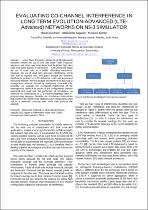 ResearchSpace
ResearchSpace
Evaluating co-channel interference in long term evolution-advanced (LTE-Advanced) networks on NS-3 simulator
JavaScript is disabled for your browser. Some features of this site may not work without it.
- ResearchSpace
- →
- Research Publications/Outputs
- →
- Conference Publications
- →
- View Item
| dc.contributor.author |
Dzivhani, Mulalo

|
|
| dc.contributor.author |
Soganile, N

|
|
| dc.contributor.author |
Bembe, Mncedisi

|
|
| dc.date.accessioned | 2017-05-17T08:44:12Z | |
| dc.date.available | 2017-05-17T08:44:12Z | |
| dc.date.issued | 2016-09 | |
| dc.identifier.citation | Dzivhani, M., Soganile, N., and Bembe, M. 2016. Evaluating co-channel interference in long term evolution-advanced (LTE-Advanced) networks on NS-3 simulator. Southern Africa Telecommunication Networks and Applications Conference (SATNAC): Broadband Evolution - Unlocking “The Internet of Things” 2016, George, Western Cape, South Africa, 4-7 September 2016 | en_US |
| dc.identifier.isbn | 978-0-620-72418-0 | |
| dc.identifier.uri | http://www.satnac.org.za/proceedings/2016/SATNAC%202016%20Proceedings%20Final.pdf | |
| dc.identifier.uri | http://hdl.handle.net/10204/9098 | |
| dc.description | Southern Africa Telecommunication Networks and Applications Conference (SATNAC): Broadband Evolution - Unlocking “The Internet of Things” 2016, George, Western Cape, South Africa, 4-7 September 2016 | en_US |
| dc.description.abstract | Long Term Evolution Advanced (LTE-Advanced) networks enables the use of new and wider radio frequency spectrum and other new technologies that facilitates high data rates and lower latency. Furthermore, LTE-Advanced adopt the use of small cells as a traffic offloading mechanism. However, the use of small cells generates interference, which may lead to capacity loss. This paper analyse the downlink interference problem in LTE-Advanced small cell augmented macrocell network. We first analyse the interference observed in homogeneous network formed by configuring macrocell only. Secondly, we evaluate the co-channel interference of the heterogeneous network as results of the configuration between macrocell and small cell. We performed all simulations via extensive NS-3 simulations on LTE-Advanced topology and C++ programming language. Notable, our simulations demonstrate that confirm the interference observed when introducing small cell in a macrocell coverage area while they enhance the network. | en_US |
| dc.language.iso | en | en_US |
| dc.publisher | www.satnac.org.za | en_US |
| dc.relation.ispartofseries | w;18070 | |
| dc.subject | Macrocell | en_US |
| dc.subject | Femtocell | en_US |
| dc.subject | Co-channel interference | en_US |
| dc.subject | NS3 | en_US |
| dc.subject | Signal-to-interference-noise-ratio | en_US |
| dc.subject | SINR | en_US |
| dc.subject | Homogeneous | en_US |
| dc.subject | Heterogeneous | en_US |
| dc.subject | NS-3 | en_US |
| dc.title | Evaluating co-channel interference in long term evolution-advanced (LTE-Advanced) networks on NS-3 simulator | en_US |
| dc.type | Conference Presentation | en_US |
| dc.identifier.apacitation | Dzivhani, M., Soganile, N., & Bembe, M. (2016). Evaluating co-channel interference in long term evolution-advanced (LTE-Advanced) networks on NS-3 simulator. www.satnac.org.za. http://hdl.handle.net/10204/9098 | en_ZA |
| dc.identifier.chicagocitation | Dzivhani, Mulalo, N Soganile, and Mncedisi Bembe. "Evaluating co-channel interference in long term evolution-advanced (LTE-Advanced) networks on NS-3 simulator." (2016): http://hdl.handle.net/10204/9098 | en_ZA |
| dc.identifier.vancouvercitation | Dzivhani M, Soganile N, Bembe M, Evaluating co-channel interference in long term evolution-advanced (LTE-Advanced) networks on NS-3 simulator; www.satnac.org.za; 2016. http://hdl.handle.net/10204/9098 . | en_ZA |
| dc.identifier.ris | TY - Conference Presentation AU - Dzivhani, Mulalo AU - Soganile, N AU - Bembe, Mncedisi AB - Long Term Evolution Advanced (LTE-Advanced) networks enables the use of new and wider radio frequency spectrum and other new technologies that facilitates high data rates and lower latency. Furthermore, LTE-Advanced adopt the use of small cells as a traffic offloading mechanism. However, the use of small cells generates interference, which may lead to capacity loss. This paper analyse the downlink interference problem in LTE-Advanced small cell augmented macrocell network. We first analyse the interference observed in homogeneous network formed by configuring macrocell only. Secondly, we evaluate the co-channel interference of the heterogeneous network as results of the configuration between macrocell and small cell. We performed all simulations via extensive NS-3 simulations on LTE-Advanced topology and C++ programming language. Notable, our simulations demonstrate that confirm the interference observed when introducing small cell in a macrocell coverage area while they enhance the network. DA - 2016-09 DB - ResearchSpace DP - CSIR KW - Macrocell KW - Femtocell KW - Co-channel interference KW - NS3 KW - Signal-to-interference-noise-ratio KW - SINR KW - Homogeneous KW - Heterogeneous KW - NS-3 LK - https://researchspace.csir.co.za PY - 2016 SM - 978-0-620-72418-0 T1 - Evaluating co-channel interference in long term evolution-advanced (LTE-Advanced) networks on NS-3 simulator TI - Evaluating co-channel interference in long term evolution-advanced (LTE-Advanced) networks on NS-3 simulator UR - http://hdl.handle.net/10204/9098 ER - | en_ZA |





